Interpret Your Pug’s Body Language – What Is She Telling You
A great starting point in getting to know your dog is to understand their body language. The reason for this, is that dogs communicate mainly by body language to you and other dogs. Dogs are very sensitive to body language, as this is the method they have used to communicate between each other for many thousands of years. Remember a dog does not look at you as another species of animal but as a superior dog (or they should otherwise you are going to have discipline problems). You are an important dog in the pack and they treat and communicate to you as such.
Greeting
Your pug will want to greet you after absence by licking your face. This is why it is natural for them to jump up at you when greeting you. Basically they are trying to get to your face to lick it, in the same way they greet other dogs in the pack. This is how they re-establish a bond. The more hyper you are when you greet your dog the more hyper they become. It is very easy to stop a dog jumping up at you when they greet you and that is to ignore them or say NO very firmly when they do it. They will quickly learn the new rules on greeting: a great tip if they are hyper on greeting, is to completely ignore them and only after they have settled down do you acknowledge them and stroke or give them a treat, they soon learn to calm down on greeting.
Eyes
Have you noticed when you look at your dog’s eyes you can often guess how they are feeling; sad maybe ill, content, happy pleased, excited, aggressive . Having similar facial expressions to us and importantly dogs use facial expressions to communicate with each other, you can actually read their eyes and facial expressions. So few animals use this form of communication but we and dogs do and this common use of communication is a large reason why we live side by side so well.
I will tell you how important the eyes are. Dogs are the only animal that you can communicate to with your eyes. If you get their attention by calling them and then look straight into their eyes, then look to the side as if you have seen something, like a rabbit, your dog will follow your eyes and look at the same place, without saying anything. Just how cool is that. Now you can understand why we have such a strong bond with dogs. We can talk to them with our eyes!
An aggressive dog will try to stare you down and returning a stare will be interpreted as a direct challenge. Never look an aggressive dog straight in the eye.
Signals and Commands
Knowing that dogs use body language to communicate between each other, it is easy then to understand that the most effective way to train your dog is by using both voice command and hand signals. Having clear hand signals, like an out stretch palm to signal stay, is the easiest way for your dog to understand what you want. Point down on the floor to signal lie down. In fact pointing is a brilliant way to say what you want. Point to where you want them to walk and they will walk that way.
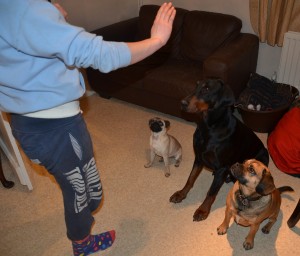
Hand Signals dogs understand much quicker and easier than voice signals. Best is to voice a command combined with an unqiue hand signal, for that command
Barking
So where does barking come into communication? Well this is another amazing fact and another reason why we love our dogs so much. Dogs very rarely bark in the wild. They bark far more now in human company because they are trying to communicate with you – over many generations they have learnt that humans respond very well to barking. Even more fascinating is that most dogs develop a number of different tonal barks, usual 5 or 6, that we can interpret as having different meanings. Think about your dog’s bark when he wants to go out, this is one tonal bark. When he can hear a stranger knock at the door, its a different bark. When she is excited because she has found a rabbit hole or her favourite ball its another bark. When your dog wants your attention and saying come here I have hurt myself, its a yelp of a bark. Think about it next time you hear him bark and how you know what he wants, without seeing him.
Howling
Most dogs howl at musical instruments or a siren of a police car or the phone. This is very instinctive for them to howl. Wolfs and dogs howl in the wild to basically say I am over here; they do it a lot at night, not to lose contact with each other. So when they howl it is responding by saying I am here. Our Tom howls if we leave him at the vets and is especially loud if we leave him at the kennels, for some reason he prefers the vet!
The Play Bow
We have all seen the play bow which is a clear sign to any other dog that their intentions are non aggressive, even when play fighting. What is less known is that puppies have a lot of leeway with the older dogs, they get away with murder, they can bite an alpha males tail, without any reprimand, sleep in the best places and the other dogs act nervously around the puppy’s food, wanting it but an instinct inside is saying do not touch it.
The ground rules only start to be enforced by the older dogs when the puppy is around 12 -14 weeks old. The mum will nip and bark if she sees bad behaviour and the alpha male will growl to ensure the new dog knows its place in the hierarchy of the pact. This for me is the most natural time to start training your puppy and starting to be firm with them. In the first few weeks just enjoy your puppy and let them rule the world, don’t worry about all the rules, plenty of time for that in the coming weeks.
Tail Wagging
- Broad tail wagging at a medium rate means she is pleased and happy and wants you to know about it.
- Wagging tail with heckles up. Communicating confused signals, not sure if she should be guarding or making friends, needs you for direction in this situation.
- Fast small side to side wagging means she is excited.
- Slow wags and the head is held slightly lower than normal, can been seen when a dog meets a new dog but is not to sure how it will go – means she feels insecure or unsure.

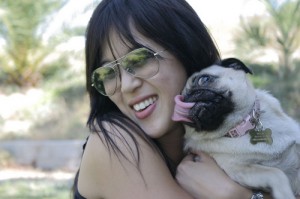
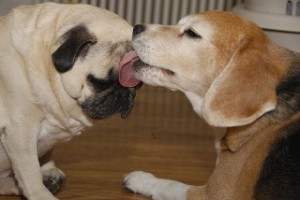
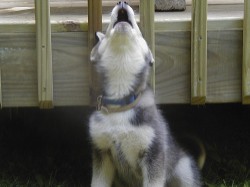
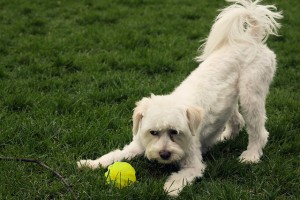
só gostaria de dizer seu blog é fantástico
. parabéns
Our pug puppy will lick us to greet us but never wags his tail at us as our other dogs do when they’re pleased to see us. He’ll wag at our other dogs, wag (very excitedly) at our cat, and wag at total strangers but he never wags at us! WE wonder what we’re doing wrong and whether he actually likes us!
Yah even my dog do the same.. he wags at neighbours.. to my family!! But hardly to me.. that makes me a bit disappointed too…
i like this but does it apply to pugs as well?
yes it applies to all dogs